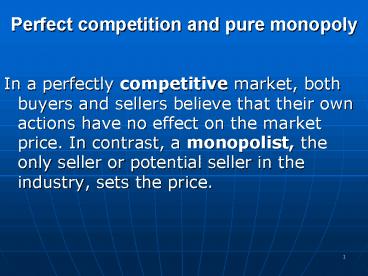Perfect competition and pure monopoly - PowerPoint PPT Presentation
1 / 10
Title:
Perfect competition and pure monopoly
Description:
A competitive firm faces a horizontal demand curve. ... We can draw the supply curve without knowing anything about the market demand curve. ... – PowerPoint PPT presentation
Number of Views:59
Avg rating:3.0/5.0
Title: Perfect competition and pure monopoly
1
Perfect competition and pure monopoly
- In a perfectly competitive market, both buyers
and sellers believe that their own actions have
no effect on the market price. In contrast, a
monopolist, the only seller or potential seller
in the industry, sets the price.
2
- Perfect competition means that each firm or
household, recognizing that its quantities
supplied or demanded are trivial relative to the
whole market, assumes its actions have no effect
on the market price. This assumption was built
into our model of consumer choice in Chapter 5.
Each consumer's budget line took market prices as
given, unaffected by the quantities then chosen.
Changes in market conditions, applying to all
firms and consumers, change the equilibrium price
and hence individual quantities demanded, but
each consumer neglects any feedback from his own
actions to market price.
3
Perfect competition
- If an individual's action does not affect the
price, a perfectly competitive industry must have
many buyers and many sellers. Each firm in a
perfectly competitive industry faces a horizontal
demand curve as in Figure 8-1. However much the
firm sells, it gets the market price, if it
charges a price above fn it will not sell any
output buyers will go to other firms whose
product is just as good. Since the firm can sell
as much as it wants at P0, it will not charge
less than P0. The individual firm's demand curve
is DD.
4
The competitive firm's demand curve
Price
DD
Po
Quantity
5
A perfectly competitive firm's supply decision
- This general theory must hold for the special
case of perfectly competitive firms. The special
feature of perfect competition is the
relationship between marginal revenue and price.
A competitive firm faces a horizontal demand
curve. Making and selling extra output does not
bid down the price for which existing output is
sold. The extra revenue from selling an extra
unit is simply the price received. A perfectly
competitive firm's marginal revenue is its output
price,
6
Global competition
- Changes in conditions in domestic markets often
reflect events abroad. Fish prices in Western
Europe fell in the 1990s after suppliers from the
ex-USSR joined the world economy. Wool prices in
the EU rise when a drought in Australia hits
sheep farmers there. Competitive markets in
different countries are linked together by
international trade.
7
- When transport costs are low, a commodity's
price in one country cannot vary much from its
price in other countries. In the extreme case,
the 'Law of One Price' holds. If there are no
obstacles to trade and no transport costs, the
price of a given commodity is the same all over
the world. Suppliers sell in the market with the
highest price, but consumers buy in the market
with the lowest price. Trade makes the two prices
the same.
8
Pure monopoly the opposite limiting case
- A perfectly competitive firm is too small to
worry about any effect of its output decision on
industry supply and hence price. It can sell as
much as it wants at the market price. We next
discuss the opposite limiting case of market
structure, the case of pure monopoly.
9
- A monopolist is the sole supplier and potential
supplier of the industry's product.
10
A monopoly has no supply curve
- A competitive firm sets price equal to marginal
cost if it supplies at all. If we know its
marginal cost curve we know how much it supplies
at each price. Aggregating across firms, we also
know how much the industry supplies at each
price. We can draw the supply curve without
knowing anything about the market demand curve.































